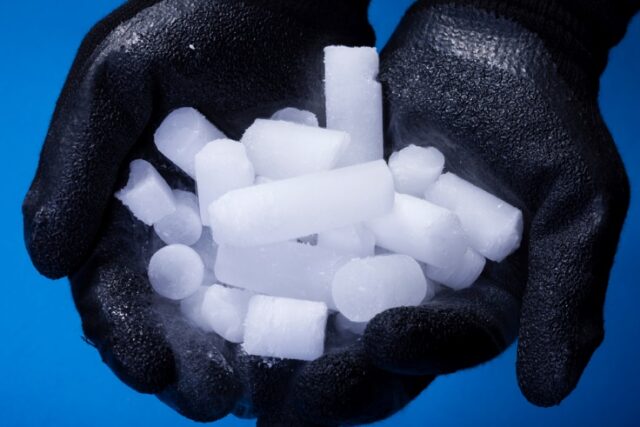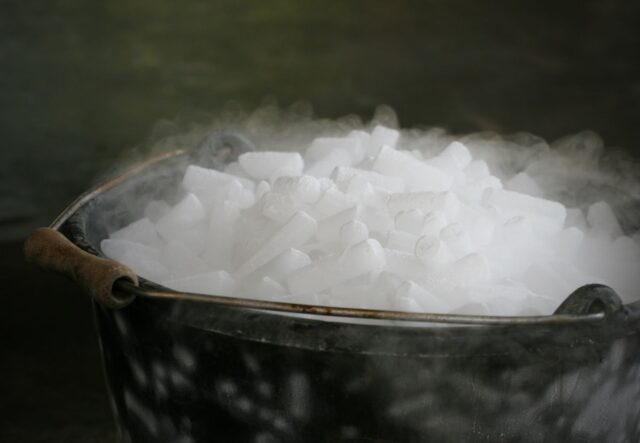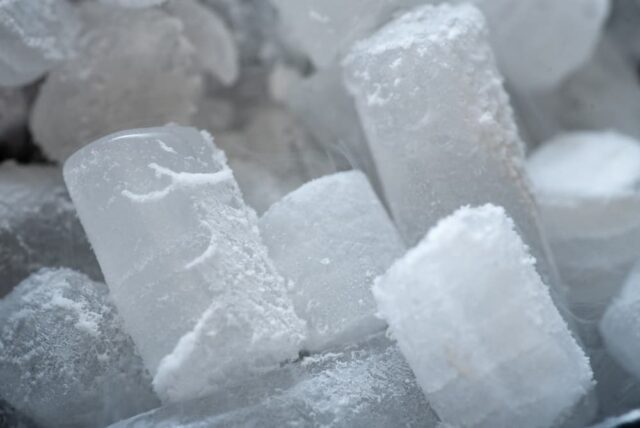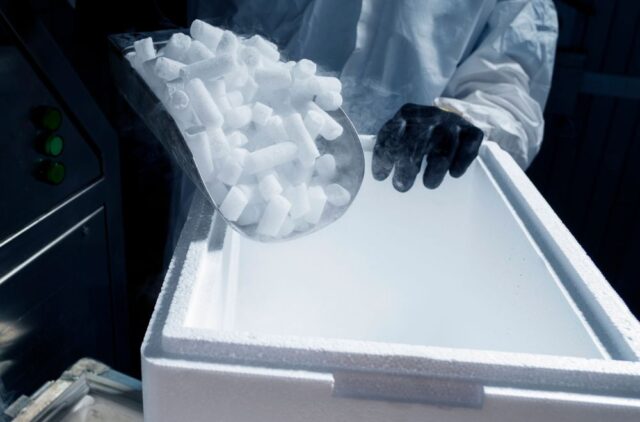
Have you ever had to dispose of dry ice? Well, let me tell you about my experience. It all started when I was left with a significant amount of it after my birthday party. I was a bit clueless about what to do with it. My first instinct was to treat it like regular ice and let it melt away. But boy, was I wrong!
Unlike regular ice, dry ice sublimates, turning directly into a gas rather than melting. This can lead to safety concerns if not properly handled. Therefore, it is crucial to dispose of it properly.
Let’s take this journey together and learn the ins and outs of its disposal.
Disposal Methods

There are several ways to safely dispose of dry ice:
- Allow it to naturally sublimate in a well-ventilated area.
- Sublimate it in water.
- Return unused dry ice to the supplier.
Regardless of the method you choose, handling dry ice safely is of utmost importance which is why you should always use insulated gloves to prevent frostbite.
Allowing Natural Sublimation
Natural sublimation is by far the most straightforward and least labor-intensive method. This process merely involves leaving the ice in a well-ventilated area and letting nature do the rest.
As it is the solid form of carbon dioxide, it does not melt like the regular one but instead sublimates. This means it transitions directly from a solid to a gas, skipping the liquid phase altogether. The warmer the surrounding temperature, the faster this process occurs. Given this, the best place to let dry ice sublimate naturally is at room temperature.
However, it’s vital to consider safety precautions when opting for this disposal method. The location you choose must be out of the reach of children and pets to avoid any accidental contact. Dry ice is extremely cold, with a surface temperature of around -78.5 degrees Celsius (-109.3 degrees Fahrenheit). Direct contact with the skin can cause severe frostbite.
Even more crucial is ensuring that the area is well-ventilated. As dry ice sublimates, it releases carbon dioxide gas. In an enclosed space, the accumulation of this gas can lead to a potentially dangerous situation. High levels of carbon dioxide can displace oxygen, leading to difficulty breathing, loss of consciousness, or even asphyxiation in extreme cases. This is why adequate ventilation is crucial.
One common method is to place the dry ice in a secure container—like an insulated cooler without a completely sealing lid—in a larger room or outside if weather permits. This way, the dry ice can sublimate at its own pace while the released carbon dioxide gas dissipates harmlessly into the atmosphere.
Remember, never place dry ice in a completely sealed container for disposal. The buildup of gas pressure could cause the container to explode.
It’s also crucial to avoid disposing of dry ice in a sink or drain, as it can severely damage your plumbing due to its extreme cold.
By observing these safety precautions, natural sublimation can be a safe and simple way to dispose of dry ice. Always err on the side of caution and ensure your disposal method prioritizes safety above all else.
Sublimating in Water

This method speeds up the sublimation process significantly, but it demands careful handling due to the intense reaction that occurs when dry ice comes into contact with water.
Here’s a step-by-step guide on how to safely sublimate dry ice in water:
- Find a Suitable Container: Start by choosing a large and sturdy container that can withstand the cold temperature of the ice and the warmth of the water. This could be a large plastic tub or a metal bucket. The container should be big enough to hold both without spilling over.
- Fill the Container with Warm Water: Fill your chosen container with warm (not hot) water. The water serves as a medium that facilitates the rapid sublimation of the dry ice. Using warm water instead of cold water speeds up the sublimation process because the higher temperature leads to a faster phase transition from solid to gas.
- Add the Dry Ice: Using insulated gloves or tongs to protect your hands from the extreme cold, carefully place it into the water. Always ensure to handle it safely to prevent frostbite or other injuries.
- Stand Back: Once you’ve added the dry ice to the water, immediately step back to a safe distance. The interaction between them will create a reaction that causes the ice to sublimate rapidly, producing a large cloud of white fog made up of condensed water vapor and carbon dioxide gas.
This white fog is often used in theatrical productions and science demonstrations for its dramatic effect. While it’s safe to be around, you should avoid breathing it in excessively as it contains carbon dioxide.
Just like with natural sublimation, this method should be performed in a well-ventilated area or preferably outdoors to allow the carbon dioxide gas to disperse safely. It’s crucial to avoid enclosed spaces, where carbon dioxide can accumulate and create a potential suffocation hazard.
This method is particularly useful when you need to get rid of a large amount of dry ice in a short period of time, just like me at the time.
Returning to the Supplier

Several suppliers offer a return option for unused dry ice, providing a convenient and responsible way of disposal. Here’s how to go about it:
- Contact Your Supplier: The first step is to get in touch with your supplier. Give them a call or check their website to see if they accept returns. Not all suppliers provide this service, so it’s crucial to confirm before attempting to return it.
- Check the Return Policy: If your supplier accepts returns, make sure to understand their return policy. They may have specific conditions for returns such as a time limit from the date of purchase, a minimum amount that can be returned, or special packaging requirements.
- Pack it properly: Packaging is essential for safe transportation. It should be stored in a cooler or other insulated container that is capable of withstanding extremely cold temperatures. Never place it in a completely airtight container as the pressure from the sublimating carbon dioxide gas could cause it to burst.
- Transport Safely: When transporting it, ensure it is secure and won’t move around. Keep the car windows slightly open for ventilation as it will continue to sublimate and produce carbon dioxide gas.
- Communicate With the Staff: Upon arrival at the supplier, inform the staff that you’re returning dry ice so they can handle it appropriately.
Returning to the supplier is not only a convenient disposal method, but it’s also environmentally friendly. It reduces the amount of carbon dioxide released into the atmosphere by allowing the supplier to reuse the dry ice.
Common Mistakes to Avoid

Common mistakes when disposing of dry ice include:
1. Trying to Dispose of it in a Sink or Toilet: This is a major mistake as the extreme cold of the ice can cause severe damage to your plumbing system. The frigid temperature can freeze the water in the pipes, causing them to crack or burst.
2. Leaving it in a Sealed Container: If left in a tightly sealed container, carbon dioxide can build up and create a significant amount of pressure, potentially causing the container to explode. This is not only damaging but can also be very dangerous.
Always store the ice in an insulated but not completely airtight container. The container should allow for the release of the gas to prevent the buildup of pressure. If you’re unsure, simply leave the lid slightly ajar or make sure the container has some sort of vent.
3. Attempting to Break Up Large Chunks: Some people might try to speed up the sublimation process by breaking up large pieces of dry ice. However, this can be very dangerous as the extreme cold can cause severe frostbite if it comes into direct contact with your skin.
Furthermore, attempting to break it with a hammer or other tool can result in shrapnel-like pieces being scattered, which can lead to potential injuries. It’s safer and more prudent to let the dry ice sublimate naturally, even if it might take a bit longer.
FAQs:
How long does it take for dry ice to completely sublimate?
The sublimation process typically takes around 24 to 48 hours, depending on the amount of and ventilation.
What are the signs of unsafe handling of dry ice?
Signs include difficulty breathing, dizziness, headaches, or disorientation, which may indicate a lack of proper ventilation.
What should I do if I accidentally touch it with bare skin?
Immediately rinse the affected area with lukewarm water. Seek medical attention if any pain or injury occurs.
Can I burn it?
Burning dry ice is not recommended, as it can release harmful gasses and cause safety hazards.
Can I dispose of dry ice in outdoor trash bins?
It is generally not recommended. Check with local regulations for proper disposal methods.
Conclusion
In conclusion, the proper and safe disposal of dry ice is achievable when you have a clear understanding of the process and guidelines involved. Whether allowing dry ice to naturally sublimate in a well-ventilated area or carefully sublimating it in water, adherence to safety protocols is essential.
By following the recommended procedures, you can handle and dispose of dry ice correctly, reducing the potential risks to yourself and those in your vicinity.












